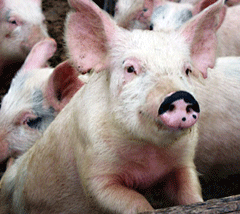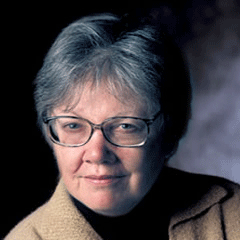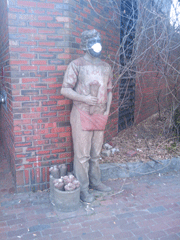Farming the Flu
Air Date: Week of May 1, 2009

The H1N1 2009 virus has a mix of genetic material linked to pigs, birds, and humans.
As health officials try to guess where the so-called swine flu will show up next, other researchers are trying to track the H1N1 virus to its origins. And a number of experts suspect large-scale factory farms. Host Jeff Young talks with Johns Hopkins Public Health Professor Ellen Silbergeld who says crowded, filthy conditions at factory farms could speed the mutation and transfer of viruses from pigs to people.
Transcript
CURWOOD: It’s Living on Earth, I’m Steve Curwood.
YOUNG: And I’m Jeff Young.
World health authorities are on alert, tracking the new flu – now officially called the H1N1 2009 flu. Not as catchy as swine flu maybe, but more accurate since scientists are still working to better understand the connection between the virus and pigs. While heath officials are trying to check the virus’s spread, other researchers working to find its origin. And some of them suspect large-scale factory farms may have played a role.

Ellen Silbergeld.
SILBERGELD: The aspects of this strain that are troubling to us are, number one: that it has clearly moved from non-human into human hosts. Number two: that it appears to readily infect one human from another human, so its transmissible among us, you don’t have to have contact with pigs or birds to get this virus. And third: that it is quite virulent, that is, it causes serious illness.
YOUNG: Now why do we suspect pigs had some role here and what is it that is special about pigs that makes them a possible conduit for a flu that humans can get?
SILBERGELD: The reason why this is notable is of course that pigs are very close to humans in terms of the immune system. And so an influenza virus that has been able to infect pigs is in some way closer to being conditioned to infecting us.
YOUNG: Why do you suspect these large-scale farms? What is it about this particular method of farming that you think makes it easier for viruses to change and to jump from species to species?
SILBERGELD: Well, this, of course, is not strictly limited to influenza viruses, but is based on observations by us and others in studying bacteria as well as viruses.
These operations contain elements that really are conducive to raising concerns for public health. You have thousands of animals, in the case of pigs usually between two and six thousand animals, held in close confinement under conditions that are not sanitary, that is frankly that they’re housed with their wastes. And therefore you’ve got a lot of hosts available to exchange a pathogen, which is one of the processes by which viruses and bacteria evolve and acquire mutations. And then the way in which these operations are run – and I want to stress that this is a worldwide issue, it is not peculiar or restricted to Mexico.

The spread of the flu has everyone worried. (Photo: Bruce Gellerman)
YOUNG: So despite their efforts to keep it secure, you can’t stop the flow of air, you can’t stop insects.
SILBERGELD: Well, the issue is most of the bio-security practices that have been developed by the industry – most of them have been to protect the animals from a person bringing in a disease that could be dangerous to the health of the animals. In terms of what we call bio-containment – that is preventing from something that might be in the house from coming out – there’s very, very imperfect and limited protection.
YOUNG: Is there evidence that the people who work at these type farms are more susceptible to catching diseases from the animals and able to spread disease to other people.
SILBERGELD: There’s considerable evidence that workers in these operations, farmers and farm workers are in fact at greater risk of exposure. Studies conducted in Iowa and other places have demonstrated that workers in swine CAFOs have a high rate of infection by swine influenzas. In the same way that we and others have reported that workers in poultry houses have a high rate of being infected by poultry born pathogens. Now – and here’s one of the tricky things – they may not be sick. I’m sure you’ve heard of Typhoid Mary – and the really worrying thing in public health is what we call the asymptomatic carrier, that is a person who’s become infected by a pathogen but does not get sick.

The H1N1 2009 virus has a mix of genetic material linked to pigs, birds, and humans.
SILBERGELD: They are one bridge. But I do want to emphasize these environmental pathways of dispersion through air and waste that may be even more important.
YOUNG: And what would be your recommendations, how could this type of farming be made less likely to produce dangerous diseases?
SILBERGELD: I think in light of this event, there are some things we should do in the short term. First and foremost, we need to recognize the critical role of industrial food animal production in the emergence of new diseases. And we need to direct much more oversight and monitoring as to what’s going on in terms of what’s happening in the animals and also in people who are really at the front line, who are the workers and the farmers and the nearby communities. These groups really aren’t part of our monitoring and surveillance programs at the same time. Second, I think we need to immediately institute much better oversight over the management of waste. Influenzas can survive in wastes for months. And yet there are no requirements for either testing or appropriate management. And this has got to be a very important switch point in this whole process globally speaking.
YOUNG: Ellen Silbergeld is professor of environmental health at Johns Hopkins Bloomberg School of Public Health. Thanks very much for your time.
SILBERGELD: Thank you.
[MUSIC: Tosca “Chocolate Elvis (Boozoo Baju Soul Sufferer Version) from Chocolate Elvis Dubs (G-Stone records 1999)]
Links
Living on Earth wants to hear from you!
Living on Earth
62 Calef Highway, Suite 212
Lee, NH 03861
Telephone: 617-287-4121
E-mail: comments@loe.org
Newsletter [Click here]
Donate to Living on Earth!
Living on Earth is an independent media program and relies entirely on contributions from listeners and institutions supporting public service. Please donate now to preserve an independent environmental voice.
NewsletterLiving on Earth offers a weekly delivery of the show's rundown to your mailbox. Sign up for our newsletter today!
 Sailors For The Sea: Be the change you want to sea.
Sailors For The Sea: Be the change you want to sea.
 The Grantham Foundation for the Protection of the Environment: Committed to protecting and improving the health of the global environment.
The Grantham Foundation for the Protection of the Environment: Committed to protecting and improving the health of the global environment.
 Contribute to Living on Earth and receive, as our gift to you, an archival print of one of Mark Seth Lender's extraordinary wildlife photographs. Follow the link to see Mark's current collection of photographs.
Contribute to Living on Earth and receive, as our gift to you, an archival print of one of Mark Seth Lender's extraordinary wildlife photographs. Follow the link to see Mark's current collection of photographs.
 Buy a signed copy of Mark Seth Lender's book Smeagull the Seagull & support Living on Earth
Buy a signed copy of Mark Seth Lender's book Smeagull the Seagull & support Living on Earth

